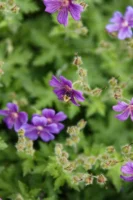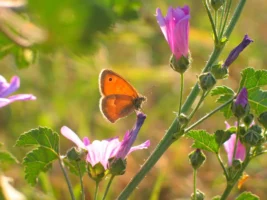
You grab a six-pack of cheerful blooms from the garden center, feeling like a hero for the pollinators.
You’ve seen the “bee-friendly” label, and you’re ready to do your part for the planet.
But what if I told you that some of the most popular “pollinator-friendly” plants are about as nutritious for bees as a cardboard box?
It’s a tough truth, but many common garden flowers are all show and no go, offering little to no sustenance for our buzzing friends.
Your good intentions might be falling flat, and it’s not your fault—it’s a common garden center trap.
The Deceptive Dozen: Pretty Flowers That Fail the Pollinator Test

Not all flowers are created equal, especially when it comes to feeding bees and butterflies.
Let’s dig into five common culprits that might be cluttering your garden and what you should plant instead.
1. The Useless Beauty: Double-Petaled Cultivars (e.g., Double Impatiens, Some Double Tulips)
These flowers are the supermodels of the plant world: stunning to look at but utterly devoid of substance.
Breeders have transformed simple, nectar-rich single flowers into fluffy, multi-petaled monstrosities.
The extra petals often block access to the pollen and nectar centers, or worse, they’ve been bred to not produce any at all.
Imagine a vending machine that’s been sealed shut—that’s what a double flower is to a hungry bee.
2. The Invasive Imposter: Butterfly Bush (Buddleia davidii)
I know, I know—the name literally has “butterfly” in it.
And it’s true, you will see butterflies fluttering around its fragrant cones.
So why is it on this list?
While it does provide a sugary sip, it’s the ecological equivalent of fast food—it offers no nutritional value for caterpillar larvae.
Worse, many varieties are highly invasive, spreading aggressively and crowding out native plants that are essential for a complete pollinator life cycle.
3. The Shocking Surprise: Some Modern Hybrids (e.g., “Sterile” Lantana, Petunias)
This one stings, doesn’t it?
Lantana and petunias are staples in summer gardens, praised for their non-stop color.
However, many modern hybrids are bred to be seedless, which often means they produce little to no pollen.
They’re essentially botanical dead ends.
The plant puts all its energy into maintaining those showy looks instead of producing the pollen and nectar that pollinators desperately need.
4. The Fragrant Fooler: French Hybrid Lavender (Lavandula stoechas)
Before you come for me, hear me out.
While all lavender is attractive to pollinators, the French hybrid variety with the cute little “rabbit ear” petals on top is far less productive than its English cousin (Lavandula angustifolia).
Its flowers are more difficult for bees to access, and it produces significantly less nectar.
You’re better off planting the classic, hardworking English lavender that bees truly adore.
5. The Empty Promise: Geraniums (Pelargonium)
Those vibrant, bomb-proof geraniums that spill out of your patio containers?
They’re practically a pollinator desert.
Their bright red and orange colors might signal a tasty meal, but they offer virtually no nectar or pollen reward.
Bees will buzz right past them in search of a more honest flower.
Plant This, Not That: Your Pollinator Power List

Now for the good news! Swapping out those duds for these powerhouse plants will transform your garden into a genuine pollinator paradise.
1. Instead of Double Flowers, Plant: Single-Petaled Native Sunflowers (Helianthus annuus)
Go for the classic, open-faced sunflowers.
Their large, pollen-rich centers are like a all-you-can-eat buffet for bees, offering both nectar and protein-packed pollen.
2. Instead of Butterfly Bush, Plant: New Jersey Tea (Ceanothus americanus) or Buttonbush (Cephalanthus occidentalis)
These native shrubs are absolute pollinator magnets.
They provide copious amounts of nectar and pollen, and they also serve as host plants for butterfly larvae, supporting the entire life cycle.
3. Instead of Sterile Hybrids, Plant: Bee Balm (Monarda) or Anise Hyssop (Agastache foeniculum)
These plants are pollinator royalty.
Their tubular flowers are nectar powerhouses, and their fragrant leaves add beauty and deer resistance to your garden.
You’ll hear the happy buzz from feet away.
4. Instead of French Lavender, Plant: English Lavender (Lavandula angustifolia)
Stick with the classics like ‘Hidcote’ or ‘Munstead’ varieties.
Their simple flower spikes are easy for bees to navigate and are prolific nectar producers.
5. Instead of Geraniums, Plant: Native Phlox or Zinnias (Benary’s Giant is a favorite)
These are the true workhorses.
Zinnias provide a flat, easy landing pad and a long season of nectar, while native phlox offers a fragrant, reliable feast for butterflies and moths.
One Final, Crucial Tip

You’ve planted all the right flowers, but your work isn’t quite done.
The single most important thing you can do is ditch the pesticides.
Even organic ones can be harmful if misapplied.
If you must treat a pest problem, opt for targeted solutions like horticultural oils or insecticidal soap, and only apply them at dusk when pollinators are not active.
A perfect flower is useless if it’s covered in poison.
Creating a truly bee-friendly garden is about more than just pretty flowers; it’s about providing real, nutritious food.
By making these simple swaps, you’re not just gardening—you’re building a lifeline.
So, what will you plant first to become a true pollinator hero?
Is Your Garden a Ghost Town for Bees and Butterflies?

Have you ever noticed the eerie silence in your yard, missing the gentle buzz of busy pollinators?
Often, the problem isn’t a lack of space, but a lack of the right plants.
Many common ornamental plants are like beautiful, empty restaurants—they offer no nutritious nectar or pollen for our vital insect friends.
So, what’s the easiest, most effective way to plant superior alternatives and turn that silence into a symphony?
The solution is simpler than you think: a carefully curated Native Wildflower Seed Mix.
Forget the guesswork; products like the American Meadows Bee and Butterfly Wildflower Seed Mix take the hassle out of helping.
This mix isn’t just a random bag of seeds; it’s a region-specific powerhouse of native species chosen for their super-high nectar value.
Imagine a garden that blooms in waves, providing a continuous buffet from spring through fall, just when these creatures need it most.
The real-world benefit is absolutely magical.
Within weeks of sowing, you’ll witness a transformation as your space comes alive with color, buzzing bees, and fluttering butterflies.
You are not just planting flowers; you are building an ecosystem.
Your immediate action? Choose a mix designed for success and get ready to host the most vibrant garden party of the season.

Leave a Reply